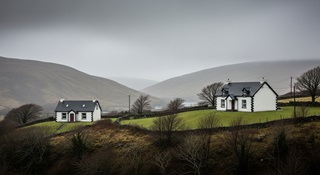Ireland’s Coldest Homes: The Counties With the Least Energy-Efficient Housing

At Calor, we wanted to uncover where in Ireland homes are struggling the most to stay warm. By analysing nationwide housing, temperature data and including energy efficiency scores we've created a Cold Homes Index to reveal which counties are facing the biggest battle to keep the heat in.
Of course, while the climate and housing stock play a role, the type of energy you use to heat your home can make a big difference. Cleaner, more efficient options like BioLPG not only help households cut down on energy use and costs but also reduce carbon emissions – meaning warmer homes and a more sustainable future.
According to the Cold Homes Index, which combines the average temperature during the winter months with energy efficiency ratings, Leitrim takes the unfortunate top spot. While beautiful and scenic, the county’s chilly climate and the high proportion of homes in lower energy bands (D–G) mean households here face long, cold winters and higher heating bills.
Sligo follows closely behind. With damp Atlantic winds and a housing stock that includes many older, rural properties, the county struggles to retain warmth. Poor insulation and low-efficiency heating systems are common, leaving residents more exposed to the cold.
In Tipperary, housing age plays a big role. The county has one of the highest shares of older, less efficient homes in Ireland, meaning even with relatively milder conditions compared to the northwest, households still lose heat quickly.
Mayo is another county where the climate and the housing stock work against residents. Winters here are long, wet, and cold, and with many rural homes falling into the lower BER categories, families often rely heavily on heating systems just to stay comfortable.
Rounding out the top five, Longford combines colder inland temperatures with older, energy-inefficient housing. With many properties built before modern insulation standards, the county’s homes demand more energy to maintain even a modest level of warmth.
Here are the top 10 counties with the coldest, least energy-efficient homes in Ireland:

These counties tend to experience lower temperatures in the winter months, but that’s only part of the problem. Many homes in these areas are older, poorly insulated, or lack access to modern, efficient heating systems - which only adds to the chill.
Several factors contribute to why certain counties have colder homes:
At the other end of the scale, Cork claims the title of Ireland’s warmest, most energy-efficient county. With a milder southern climate and a growing number of newer, better-insulated homes, households here benefit from lower heating demand and greater comfort during winter.
Carlow comes next, helped by its inland location and relatively compact housing stock. A significant share of homes in the county score higher on the BER scale, meaning less heat is lost and households can keep energy use under control.
In Waterford, a balance of coastal climate and improved energy standards has kept residents warmer. The county’s housing stock has a comparatively lower proportion of homes in the least efficient bands, giving it a strong performance on the index.
Dublin also ranks highly. While the capital has plenty of older homes, high-density housing and widespread investment in retrofits and newer developments mean that overall efficiency levels are stronger than much of the country.
Finally, Galway rounds out the top five. Despite its exposure to the Atlantic, newer housing developments and retrofit efforts have given residents better insulation and efficiency than their western neighbours, helping to hold in the heat.
Here are the counties with the best performance on the Cold Homes Index:
No matter where you live in Ireland, there are steps you can take to improve your home’s warmth and efficiency: